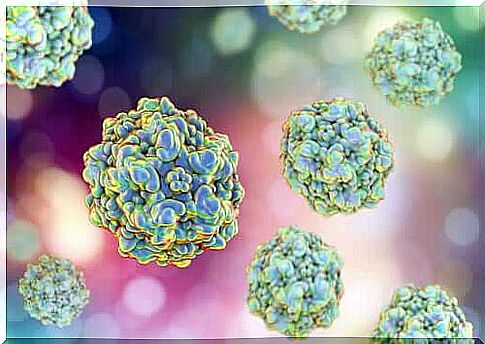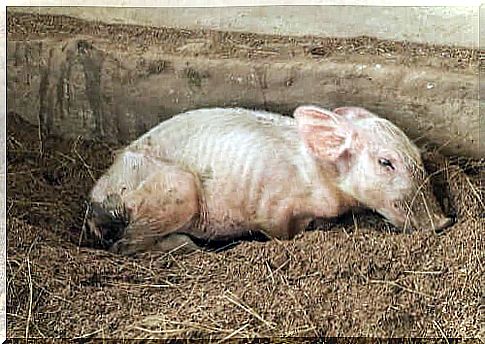Microorganisms That Cause Chronic Fatigue In Animals

There are several microorganisms capable of affecting living beings. That’s why both humans and animals can sometimes get sick. Thus, it is interesting to know which microorganisms cause chronic fatigue.
To pursue this matter, we first need to clarify two fundamental questions:
- A microorganism is a single-celled organism so small that it can only be seen with a microscope or an electron microscope, just like viruses, which are ultramicroscopic. Pathogenic microorganisms are capable of causing diseases in animals, plants and people.
- Fatigue is a symptom associated with several disorders, such as physical exhaustion, decreased cognitive capacity or sleep disorders. This should not be confused with the tiredness we feel after doing physical activity.
Below, we will discuss some examples of animals that suffer from this pathology and the scientific evidence known so far, aspects that will help us understand the importance of these beings that, despite being so tiny, play a crucial role in the health of animals.
Chronic Fatigue Syndrome
Chronic fatigue syndrome (CFS), also known as ‘myalgic encephalomyelitis’ (MS), is an illness that starts with a flu-like episode.
It has symptoms of intense fatigue, both physical and mental, in such a way that it lasts over time (minimum of 6 months). It can cause problems with concentration, memory and muscle pain. It is attributed by some professionals to a psychiatric disorder.
Until a few years ago, I believed – that this condition was unique to humans, but several studies have shown cases of CFS in animals, such as horses and pets, which would indicate a possible case of zoonosis.

The cause, diagnosis and treatment of this syndrome appear to be unclear today, but everything points to an infection of the central nervous system (CNS), viral or bacterial, followed by an immune system disorder.
Research has revealed the presence of a variety of pathogens capable of causing lifelong infections by evading the immune system:
- parvovirus
- HHV6 (human herpes)
- Mycoplasma (pneumonia)
- Cytomegalovirus (herpes virus)
- Epstein-Barr (mononucleosis) variants
- And even fungi or other biotoxins
Microorganisms that cause chronic fatigue
Bacteria, parasites and viruses are microorganisms that can cause fatigue, or rather, that can be involved in chronic fatigue syndrome.
Bacteria
A study conducted in England suggested that horses could also have CFS. In fact, it has been confirmed that there is a relationship of this disease between humans and companion animals.
The experiment was done with four horses. Two of them had fatigue and chronic weakness that made physical effort difficult. They looked depressed, keeping their heads down and their lips drooping, as well as looking sleepy and listless. The other two horses showed symptoms of weakness, asthenia and underweight.

Through a blood smear and blood culture tests, they were all found to carry micrococcal-like bacteria that were otherwise not present in healthy horses.
The author of that same study had previously tested cats and dogs carrying micrococci in their blood and the result was positive for Staphylococcus intermedius and Staphylococcus xilosus . Therefore, it is possible to say that bacteria are microorganisms that cause chronic fatigue.
parasites
In another study published in the journal Progress in Neurobiology , scientists used rats as the model for studying fatigue. As a result, they found that both Cryptosporidium parvum and Toxoplasma gondii infections affected the activity of rats running on wheels for several weeks.
The Trypanosoma brucei parasite (which causes sleeping sickness) causes daytime sleepiness and insomnia in infected rats. Once installed in the blood, it can invade other tissues, such as the nervous system. In all cases, these single-celled parasites have been shown to cause chronic fatigue.
Virus
Other microorganisms that cause chronic fatigue are viruses. Several studies have confirmed that CFS is caused by a set of brain syndromes attributed to viral encephalopathies. In fact, the following viruses have been found to be associated with this pathology:
- parvovirus
- Enterovirus
- Epstein-Barr
- Cytomegalovirus
While some of them are found in the cerebrospinal fluid itself and experts suggest that this is where they cause the infection, others are found elsewhere in the body and go on to indirectly infect the CNS.
Another article on medical hypotheses points out that viruses are infectious agents that are more likely to cause this disease than bacteria, based on the following ideas:
- This disease is associated with changes in brain function and we know that the viruses cause behavioral changes.
- Viruses of the genus Circovirus and polyomavirus can penetrate the brain and replicate within it. Circovirus does not cause pathogenicity in humans, but rather in animals, such as the multisystem wasting syndrome of weaners, in which there are CFS-like symptoms.
- CFS usually occurs due to some systemic illness, infection, or severe stress. These conditions can cause the virus to enter the blood and pass to the CNS, suppressing the immune system and increasing your viral load, as seen in circovirus.

Viruses of the Picornaviridae family , which include enteroviruses, are present in the healthy population. However, many enteroviruses have caused CFS and several subtypes are known to sometimes affect the brain. On the other hand, viruses of the herpes family and parvovirus have a similar profile.
Microorganisms always give clues
The study of bacteria, parasites and viruses allows us to understand infectious diseases and develop effective treatments against them.
However, microbiology goes much further. This scientific field tries to help us understand the importance of these ‘invisible’ organisms, because without them, life would not exist. They have a fundamental role in nature so that countless biological processes can occur, among other vital processes.









